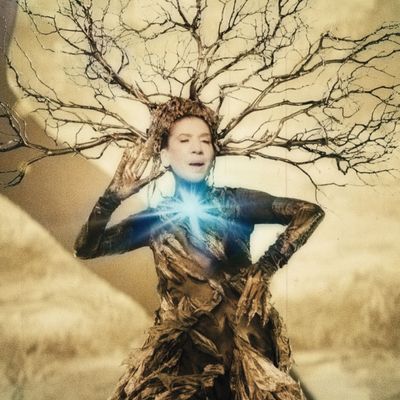
In 1982, Godfrey Reggio forever changed cinema — and, really, pop culture in general — with Koyaanisqatsi, a documentary built around mesmerizing, otherworldly images of human activity set to a now-immortal Philip Glass score. The film’s despairing, godlike perspective struck a nerve in the early, yuppified ’80s: The title came from a Hopi word meaning “life out of balance,” and Reggio, himself a former monk, captured our complacency and destructive routines in a series of breathtaking sequences. But while Koyaanisqatsi was certainly disturbing, it was also beautiful — like, “enlarge any frame and hang it on a wall” beautiful — so it had an immediate impact in the world of advertising as well, and pretty soon the film’s style was itself commodified. As Reggio once told me, “We created a language to describe the nature of the beast, and the beast took our language and used it to describe itself.”
Reggio followed Koyaanisqatsi up with two sequels: 1988’s Powaqqatsi (which focused on the Global South) and 2002’s Naqoyqatsi (which focused on humanity’s confluence with technology), as well as a number of other similarly wordless, artfully oblique films (including the 2014 feature Visitors). Now, at the age of 83, he’s returned with Once Within a Time, which is somehow both very much a Godfrey Reggio film and unlike anything he’s ever done. We could call it his first narrative picture, although it’s certainly not a conventional one. Amid the rough contours of its story, actors perform in pantomime while solo instruments and other effects stand in for their voices. The story feels like a fever dream you might have after binging the Book of Genesis and the Greek myths. There’s Mother Muse, a singing tree with, in Reggio’s words, “its roots in hell.” There’s the Apple Man, a clownish demon who offers the movie’s Adam and Eve what could be the fruit of knowledge, or the fruit that helped Sir Isaac Newton discover gravity, or the tech company that puts the world at our fingertips. “We’re a human animal,” Reggio says today, speaking to me from New Mexico, where he’s lived most of his life. “We’re human and animal — we forget that. We’re like Perdue chickens, and we’re on the feedlot of Apple and Google and TikTok.”
Once Within a Time forgoes the ethereal aesthetic of Reggio’s earlier work in favor of something more agitated, busier, chaotic. Even Philip Glass’s moving score has a carnivalesque quality to it this time. Shot on miniature sets into which actors were composited, with each frame endlessly layered and processed, the film feels out of time. It has silent-movie elements — in the actors’ wordless performances, in the charmingly handmade effects, and the dusty, grainy quality of the image — but the sophisticated clutter of Reggio’s frames is something only modern technology could make possible. Here, too, the director seems to be returning the aforementioned beast a favor: He’s turning the texture of modern life back on itself, as a way of undercutting it. In one early iteration of the project, Reggio intended to release it in short segments to be watched on mobile phones. “You start a fire to fight a fire,” he tells me. “This is a viral anti-technology film using technology, embracing the contradictions of this not or that, but this and that.” (Yes, this is how Godfrey Reggio speaks. It’s one of the reasons why I’ve always loved talking to him.)
And then there’s … Mike Tyson? Mike Tyson is in this movie, too, as a kind of magician–Pied Piper character who transfixes a group of children and then leads them to what appears to be a journey of liberation. Reggio tells me that he was drawn to the former boxer’s charisma and innate brightness. “He’s perspicacious,” Reggio says. “Nobody wanted him because he’s a felon, but there are more kids named after him than all the basketball stars, dictators, popes put together. Everybody wanted to meet him.” Tyson is another of those expressive performers that Reggio clearly loves. “You didn’t need to direct him,” he says. “You just had to give him an idea.” We don’t hear Tyson’s voice in the film, but, as the director puts it, “we can see what he’s fucking saying. His body language, facial expression, his tongue, his big face, in your face, the big tattoo.”
Children show up often in Reggio’s films. Indeed, he spent much of his time as a monk working with street gangs in the 1960s; it’s what got him kicked out of the Christian Brotherhood, he says. Children can make for an easy symbol, of course — of innocence, of impulse, of an idyllic state that humanity has lost — but Reggio’s vision has always been somewhat more complicated. “I find, with great sadness, that most kids are becoming socialized to the world,” he says. “In one day, a kid will see on the gizmo more images than a kid in the Middle Ages will have seen in a lifetime. Hear more sounds. They know everything.” (“Gizmo,” by the way, is Reggio’s preferred term for mobile phones.) In this sense, the children of Once Within a Time don’t necessarily represent innocence but humanity in general — the way we become transfixed by technology, the way we take all knowledge at face value, both our openness and our ignorance. They could stand in for our diminution in the presence of all the noise of the world, or they could stand for our potential for growth.
Reggio certainly has his ideas, but what makes his films so refreshing and endlessly rewatchable is that he’s never been blunt about what his movies mean. He embraces contradiction and aggressive ambiguity. He wants to overwhelm us so that we’ll feel the need to find the meaning ourselves. “In the Old Testament, the Jews didn’t use the magic vowels,” he says. “Everything was commentary by rabbi this and rabbi that and rabbi the other. It was an autodidactic experience because it was subjective. You are the vowel. You complete the story. When we put a frame around a picture, everyone sees a different story.” Once Within a Time runs 52 minutes, and it’s so lovely, funny, and charming that it feels like 15. But when it’s over, you feel like you’ve seen the world.
More Movie Reviews
- Fair Play Never Gives Itself a Fair Shot
- We Don’t Talk Enough About the Bizarre Exorcist Films
- Cat Person Is Cringe Horror





